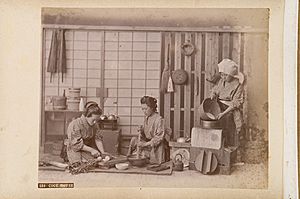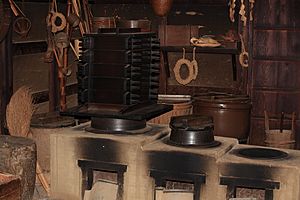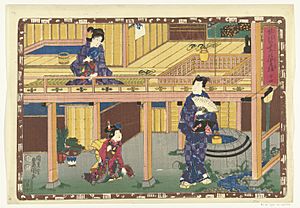Japanese kitchen facts for kids
The Japanese kitchen (called Daidokoro in Japanese) is the special place in a Japanese house where food is made. For a long time, until the Meiji era, the kitchen was also known as kamado, which means "stove." This word was very important. It was even used to mean "family" or "household," much like how we might say "hearth" in English. For example, if a family split up, people would say kamado wo wakeru, meaning "to divide the stove." If a family was broken, they would say kamado wo yaburu, or "break the stove."
Contents
Ancient Kitchens
In the Jōmon period (from about 10,000 BC to 300 BC), people lived in villages. Their homes were simple pit dwellings, like shallow huts dug into the ground. These huts were small, about 10 to 30 square meters. They had a hearth (a fireplace) in the middle. At first, these stoves were just shallow pits. But soon, people surrounded them with stones to stop sparks from flying. Later, a bottomless clay pot replaced the stones, making the stove safer. This type of stove was called umigamero. As stoves became safer, they moved from the center of the house to the side. By the late Kofun period (6th century), most houses had a stove at one end. Some rich families even built a separate building just for cooking. In these early homes, food was kept in sacks and pots in holes dug in the floor. Houses were often built near rivers or springs for easy access to water.
During the Yayoi period (300 BC to AD 250), growing rice became very popular. Villages were built near wet, low-lying areas. The water was often muddy, so people dug shallow wells called Asaido. These wells were filled with sand and pebbles to filter the water. Some villages also stored food outside in big storehouses.
The kitchen stayed pretty much the same for over 500 years, from the Nara period (8th century) to the Muromachi period (1336–1573). Kitchens had several important items:
- Ashikanahe: A large iron pot with nine or ten legs.
- Kakekanahe: An iron pot that hung over the stove, used to boil rice into kayu (a type of rice porridge).
- Koshiki: A wooden basket placed on top of a pot to steam cook rice.
- Nabe: Pots made of clay or metal, used for stews, side dishes, and boiling water.
- Kamado: The stove itself, built with stones, tiles, and clay.
- Takigi: Dried wood used as fuel for the fires.
- Oke: A tub or pail for water.
- Shaku: A wooden ladle to scoop water.
- Katana: A cooking knife (not the sword).
- Kiritsukue or Manaita: A cutting board.
- Kame: A large pot for storing food.
In the Heian period (794–1185), the word "daidokoro" (meaning pantry or kitchen) first appeared. The imperial palace had special rooms for food. One room, "Ōidono," was for cooking and was placed far from where people lived. Another room, "Daibandokoro," was where food was served on a special lacquered table.
During the Kamakura period (1185–1333), kitchens slowly became part of the main house. Before this, kitchens were often built as separate buildings. This was to keep smoke and smells away and to stop kitchen fires from spreading. Early Kamakura kitchens did not have sinks or wells inside.
Fire and Water in the Kitchen
Stoves and Heat

The very first homes in Japan used an open fire for cooking. The first actual stove, called a kamado, appeared in the Kofun period (3rd to 6th century). These stoves were usually made of clay and sand. You would feed wood into a hole at the front, and a pot would sit in a hole on top. This type of stove was used for hundreds of years. By the 14th century, during the Muromachi period, some stoves had two holes for cooking. By the early 17th century (the start of the Edo period), large stoves with many cooking holes were common in rich homes and big restaurants. These early stoves were low, so cooks had to squat. But in bigger kitchens, like those in palaces, taller kamado were developed during the Edo period, allowing cooks to stand.
Another type of stove, the Irori, appeared in the Kofun period. This was a secondary stove. A section of the wooden floor was removed, and a square wooden frame was put in its place. This frame was filled with sand, and an iron hook hung from the ceiling. Food could be cooked or reheated in a pot hanging from this hook. The fire also provided heat for the room. The irori became common in many homes by the early Nara period. A smaller irori is still a key part of a tea house.
A third type of stove, the hibachi (meaning "fire pot"), appeared later, in the early Heian period. A hibachi is a deep, small pot partly filled with sand and ash, where a small fire was started. It was a safer way to heat a room and could also be used to cook small bits of food.
Water in the Kitchen
Fire was always part of the kitchen, but water took longer to become a built-in feature.
In the Yayoi period (300 BC to AD 250), when rice farming spread, villages were built near marshes. The water was muddy, so people dug shallow wells called asaido. These wells had sand and pebbles to filter the water. Deeper wells were also dug, sometimes with hollowed logs inside to stop the walls from collapsing. People used pots to scoop water from these wells.
Later, people improved these wells. The area around a well was tiled with stones. Then, fune (water boats or reservoirs) were invented. Wooden or bamboo pipes were used to bring water from nearby wells or springs to a fune. Women also carried water by hand to fill them. Water was then taken from these fune to a water pot for use. Sometimes a fune was made inside a house, but it was only for collecting and storing water, not for washing. These fune later became part of Japanese gardens.
The first time a sink appeared in a drawing was in the early Muromachi period. A temple kitchen had a large sunokoyuka (a drainboard floor made of split bamboo) next to the stove. Water would drain through the gaps. This was a new idea for a kitchen, as washing was usually done over a river. This didn't cause health problems because kitchen scraps were carefully collected for compost. Most Japanese people did not eat meat, and animals were prepared away from the house. This type of kitchen was common until the late Edo period.
Kitchens in Shoin-zukuri Homes
The Shoin-zukuri style of housing became popular in the 13th century. It was a big change because it brought fire (the stove) and water (the well and drain) together in one place. At first, the kitchen was not a room inside the main house. It was in a separate building connected by a hallway. However, it did have a kamado, an irori, a well, and a sunokoyuka all in the same room.
In the Edo period (1603 to 1868), daidokoro officially meant "kitchen" and became a part of the main house. It was also often called katte, which means "back door." Rich homes had very large kitchens. For example, the country house of Tokugawa Mitsukuni, a famous food lover, had kitchen areas of about 53 square meters. This was more than a third of his entire house! Some kitchens even had running water through bamboo pipes. Most houses, except the very smallest, had a separate kitchen inside.
Kitchens in this period also had mizuya tansu. These were Japanese-style chests with sliding doors and drawers for storage. You can still find them today as antiques.
Modern Kitchens
When Japan started to industrialize in the early Meiji period (1868–1912), kitchens didn't change much at first. Gas and electricity were just starting to be used in homes in other parts of the world. It was expensive to set up these new systems in Japan, but companies worked hard to do it.
The early 1900s brought big changes to Japanese cuisine. New foods from around the world became popular, like curried rice, sukiyaki, ramen, and gyūdon. This was part of the haikara (meaning "high-collared," referring to Western styles) movement. Kitchens had to be reorganized to cook these new dishes, as older kitchens were only set up for simple meals of rice, fish, soup, and pickles.
Gas lights appeared in Yokohama by 1873, but it took over 30 years for gas to be used widely in homes. Even then, it was mostly for lighting. Only about 1 in 100 homes used gas for cooking. Gas companies realized this, but early gas appliances from England were too expensive for most people.
The first gas appliance to become popular in Japanese homes was the gas-heated rice cooker. Gas stoves came much later because gas was still too costly. Unlike in many Western homes, large gas ovens never became common. Instead, smaller fish grills were built into gas stoves. The gas rice cooker was used until the 1970s, when electric rice cookers took over.
In the 1920s, electricity became more common in Japanese homes. An encyclopedia from 1927 even talked about a "completely electric house." It said that using electricity for everything would help women work more easily and make life more comfortable. It mentioned electric stoves, ovens, refrigerators, and dishwashers as important for a modern kitchen. However, this was still a dream for most. A 1937 study showed that very few homes had electric appliances like refrigerators (only about 12,000 in all of Japan).
Public water service began in Yokohama in 1887. By the early 1900s, most big cities had water services, but often this meant public water taps in the street. In 1892, less than 1 in 4 homes in Yokohama had a private water tap. By the 1930s, most new houses had private taps, but it took another 30 years for them to reach villages far from cities.
The "Dream Kitchen" and Taishō Period Changes
In 1912, a women's magazine held a contest for an "ordinary people's sophisticated kitchen." The winning designs were spacious, about 15.5 square meters. They had two kamado stoves, a portable charcoal stove, and a stone sink without a tap. There were shelves for pots, dishes, and food. A large table was used for preparing food, with drawers for tools. Rice, sugar, and flour were kept in pots under the table. Windows with glass panes and electric lights made the kitchen brighter. Even this "dream kitchen" lacked many modern conveniences we have today.
Around this time, many families started using a low table called a chabudai. Everyone sat around it to eat, instead of using individual tables. Eating on chairs at a dining table was considered very "Western" until the 1960s.
In the Taishō period (1912–1926), a movement called "Taishō Democracy" led to many modern changes. Kitchens were redesigned so people could work while standing, as gas stoves and Western clothes became popular. Also, the stove and sink were moved to the same level as the rest of the kitchen floor, so you didn't have to step down into a dirt area.
In 1922, a company started selling a "System Kitchen." This was a customizable kitchen set with pre-made parts. It included a sink, a cutting board, and cabinets. It was expensive, costing 120 yen when a bank worker earned only 50 yen a month.
By the end of the Taishō period, fewer families had maids. This meant kitchens needed to be smaller for a housewife working alone. While European kitchens were about 6.46 square meters, Japanese kitchens aimed for an even smaller size, about 3.3 square meters. These small kitchens had cupboards, stoves, storage, and a sink packed into three sides.
Post-War and Contemporary Kitchens
Many Japanese houses were destroyed in World War II. This allowed architects to redesign homes and kitchens. The old Edo-period ways of living were mostly gone. Electricity and gas were built into kitchens, and designs changed to fit this. The electric refrigerator, once a luxury, became common in the 1950s, along with washing machines and black-and-white televisions. However, early post-war housing was sometimes poorly designed, simply copying Western plans. Kitchens were small and quickly became cluttered with new appliances.
The "System Kitchen" idea aimed to make kitchens easier for housewives. Designers studied how people actually cooked to create a smooth process. In a system kitchen, appliances like the refrigerator were placed in specific spots, and storage was divided for pots, pans, and utensils.
A typical modern Japanese kitchen today usually includes:
- Counter: Often made of cultured marble, but wood or natural stone are used in fancier kitchens. Stainless steel is common in commercial or cheaper kitchens.
- Large sink
- Cabinets
- Refrigerator and freezer: In smaller apartments, the top is often low enough to use as extra counter space. Larger kitchens have full-height fridges.
- Gas or induction stove: Smaller kitchens might have one or two burners, while most have three or four, often with a narrow grill underneath for fish or vegetables. In some apartments, stoves are not built-in but are separate appliances connected by a hose. In case of earthquakes, the gas tap should be turned off.
- Electric rice cooker: Over 95% of Japanese homes have one.
- Electric water boiler or kettle: Used for making tea or instant ramen.
- Toaster oven
- Microwave oven or convection microwave
- Extractor hood or fan
You might notice that large ovens and dishwashers are often missing. Large gas ovens are found in some high-end homes, but convection microwaves are more common for baking. Dishwashers are common in houses and condos but rare in apartments.
ja:台所





